Abstract
The multiplex ligation-dependent probe amplification (MLPA) assay is the most powerful tool in screening for deletions and duplications in the dystrophin gene in patients with Duchenne and Becker muscular dystrophy (DMD/BMD). The efficacy of the assay was validated by testing 20 unrelated male patients with DMD/BMD who had already been screened by multiplex PCR (mPCR). We detected two duplications that had been missed by mPCR. In one DMD patient showing an ambiguous MLPA result, a novel mutation (c.3808_3809insG) was identified. MLPA improved the mutation detection rate of mPCR by 15 %. The results of our study (1) confirmed MLPA to be the method of choice for detecting DMD gene rearrangements in DMD/BMD patients, (2) showed that ambiguous MLPA amplification products should be verified by other methods, and (3) indicated that the MLPA method could be used in screening even for small mutations located in the probe-binding regions.




Similar content being viewed by others
References
Bakker E, Van Broeckhoven C, Bonten EJ, van de Vooren MJ, Veenema H, Van Hul W, Van Ommen GJ, Vandenberghe A, Pearson PL (1987) Germline mosaicism and Duchenne muscular dystrophy mutations. Nature 329:554–556
Beggs AH, Koenig M, Boyce FM, Kunkel LM (1990) Detection of 98 % of DMD/BMD gene deletions by polymerase chain reaction. Hum Genet 86:45–48
Bushby KM, Thambyayah M, Gardner-Medwin D (1991) Prevalence and incidence of Becker muscular dystrophy. Lancet 337:1022–1024
Chamberlain JS, Gibbs RA, Ranier JE, Caskey CT (1990) Multiplex PCR for the diagnosis of Duchenne muscular dystrophy. In: Innis MA, Gelfand DH, Sninsky JJ, White TJ (eds) PCR Protocols: a guide to methods and applications. Academic Press, San Diego, pp 272–281
Den Dunnen JT, Grootscholten PM, Bakker E, Blonden LA, Ginjaar HB, Wapenaar MC, van Paassen HM, van Broeckhoven C, Pearson PL, van Ommen GJ (1989) Topography of the Duchenne muscular dystrophy (DMD) gene: FIGE and cDNA analysis of 194 cases reveals 115 deletions and 13 duplications. Am J Hum Genet 45:835–847
Emery AE (1991) Population frequencies of inherited neuromuscular diseases: a world survey. Neuromuscul Disord 1:19–29
Forrest SM, Cross GS, Flint T, Speer A, Robson KJ, Davies KE (1988) Further studies of gene deletions that cause Duchenne and Becker muscular dystrophies. Genomics 2:109–114
Gatta V, Scarciolla O, Gaspari AR, Palka C, De Angelis MV, Di Muzio A, Guanciali-Franchi P, Calabrese G, Uncini A, Stuppia L (2005) Identification of deletions and duplications of the DMD gene in affected males and carrier females by multiple ligation probe amplification (MLPA). Hum Genet 117:92–98
Hoffman EP, Brown RH Jr, Kunkel LM (1987) Dystrophin: the protein product of the Duchenne muscular dystrophy locus. Cell 51:919–928
Hu XY, Ray PN, Murphy EG, Thompson MW, Worton RG (1990) Duplicational mutation at the Duchenne muscular dystrophy locus: its frequency, distribution, origin, and phenotype-genotype correlation. Am J Hum Genet 46:682–695
Hwa HL, Chang YY, Chen CH, Kao YS, Jong YJ, Chao MC, Ko TM (2007) Multiplex ligation-dependent probe amplification identification of deletions and duplications of the Duchenne muscular dystrophy gene in Taiwanese subjects. J Formos Med Assoc 106:339–346
Janssen B, Hartmann C, Scholz V, Jauch A, Zschocke J (2005) MLPA analysis for the detection of deletions, duplications and complex rearrangements in the dystrophin gene: potential and pitfalls. Neurogenetics 6:29–35
Koenig M, Hoffman EP, Bertelson CJ, Monaco AP, Feener C, Kunkel LM (1987) Complete cloning of the Duchenne muscular dystrophy (DMD) cDNA and preliminary genomic organization of the DMD gene in normal and affected individuals. Cell 50:509–517
Koenig M, Beggs AH, Moyer M, Scherpf S, Heindrich K, Bettecken T, Meng G, Müller CR, Lindlöf M, Kaariainen H, De la Chapelle A, Kiuru A, Savontaus M-L, Gilgenkrantz H, Récan D, Chelly J, Kaplan J-C, Covone AE, Archidiacono N, Romeo G, Liechti-Gallati S, Schneider V, Braga S, Moser H, Darras BT, Murphy P, Francke U, Chen JD, Morgan G, Denton M, Greenberg CR, Wrogemann K, Blonden LAJ, Van Paassen HMB, Van Ommen GJB, Kunkel LM (1989) The molecular basis for Duchenne versus Becker muscular dystrophy: correlation of severity with type of deletion. Am J Hum Genet 45:498–506
Kunkel LM, Snyder JR, Beggs AH, Boyce FM, Feener CA (1991) Searching for dystrophin gene deletions in patients with atypical presentations. In: Lindsten J, Petterson U (eds) Etiology of human diseases at the DNA level. Raven Press, New York, pp 51–60
Lai KK, Lo IF, Tong TM, Cheng LY, Lam ST (2006) Detecting exon deletions and duplications of the DMD gene using multiplex ligation-dependent probe amplification (MLPA). Clin Biochem 39:367–372
Leiden Muscular Dystrophy pages (2003). Leiden University Medical Center (LUMC). http://www.dmd.nl. Accessed 22 July 2011
Miller SA, Dykes DD, Polesky HF (1988) A simple salting out procedure for extracting DNA from human nucleated cells. Nucleic Acids Res 16:1215
Monaco AP, Bertelson CJ, Liechti-Gallati S, Moser H, Kunkel LM (1988) An explanation for the phenotypic differences between patients bearing partial deletions of the DMD locus. Genomics 2:90–95
Moser H (1984) Duchenne muscular dystrophy: pathogenic aspects and genetic prevention. Hum Genet 66:17–40
Nobile C, Marchi J (1994) A refined restriction map of YAC clones spanning the entire human dystrophin gene. Mamm Genome 5:566–571
Okizuka Y, Takeshima Y, Awano H, Zhang Z, Yagi M, Matsuo M (2009) Small mutations detected by multiplex ligation-dependent probe amplification of the dystrophin gene. Genet Test Mol Biomarkers 13:427–431
Pikó H, Vancsó V, Nagy B, Bán Z, Herczegfalvi A, Karcagi V (2009) Dystrophin gene analysis in Hungarian Duchenne/Becker muscular dystrophy families—detection of carrier status in symptomatic and asymptomatic female relatives. Neuromuscul Disord 19:108–112
Schouten JP, McElgunn CJ, Waaijer R, Zwijnenburg D, Diepvens F, Pals G (2002) Relative quantification of 40 nucleic acid sequences by multiplex ligation-dependent probe amplification. Nucleic Acids Res 30:e57
Schwartz M, Dunø M (2004) Improved molecular diagnosis of dystrophin gene mutations using the multiplex ligation-dependent probe amplification method. Genet Test 8:361–367
Todorova A, Todorov T, Georgieva B, Lukova M, Guergueltcheva V, Kremensky I, Mitev V (2008) MLPA analysis/complete sequencing of the DMD gene in a group of Bulgarian Duchenne/Becker muscular dystrophy patients. Neuromuscul Disord 18:667–670
Wang Q, Li-Ling J, Lin C, Wu Y, Sun K, Ma H, Jin C (2009) Characteristics of dystrophin gene mutations among Chinese patients as revealed by multiplex ligation-dependent probe amplification. Genet Test Mol Biomarkers 13:23–30
Acknowledgments
We thank the families and patients for their cooperation. This work was supported by grant number 072-1083107-0365 from the Ministry of Science, Education, and Sports, Republic of Croatia.
Author information
Authors and Affiliations
Corresponding author
Rights and permissions
About this article
Cite this article
Sansović, I., Barišić, I. & Dumić, K. Improved Detection of Deletions and Duplications in the DMD Gene Using the Multiplex Ligation-Dependent Probe Amplification (MLPA) Method. Biochem Genet 51, 189–201 (2013). https://doi.org/10.1007/s10528-012-9554-9
Received:
Accepted:
Published:
Issue Date:
DOI: https://doi.org/10.1007/s10528-012-9554-9




